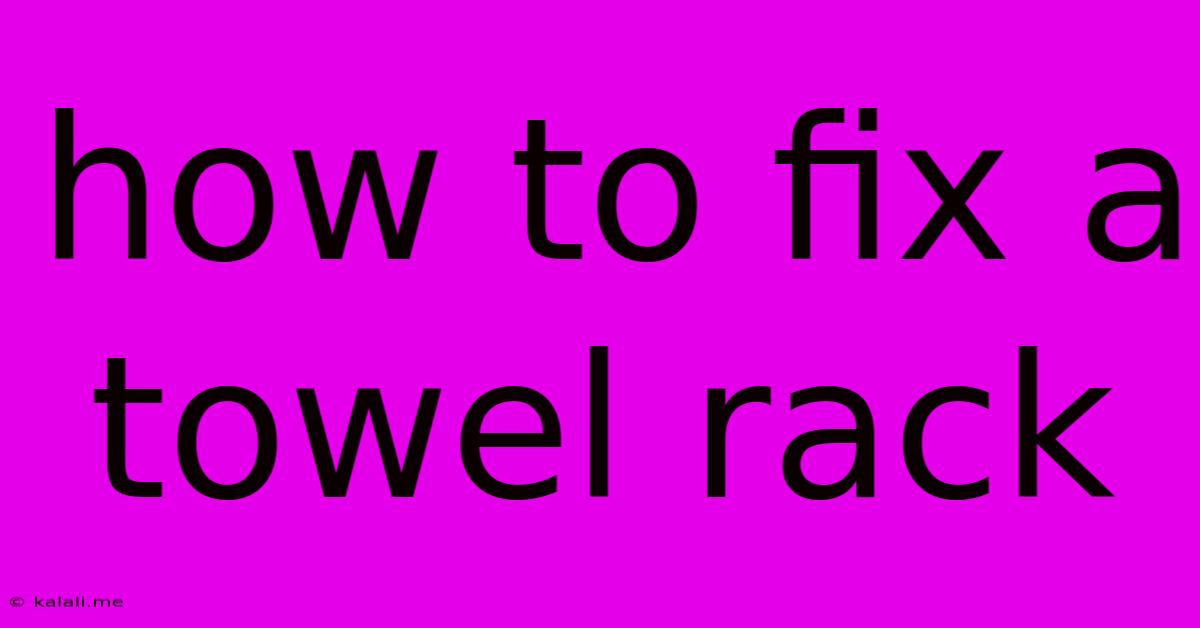How To Fix A Towel Rack
Kalali
Jun 04, 2025 · 3 min read

Table of Contents
How to Fix a Wobbly or Loose Towel Rack: A Step-by-Step Guide
A wobbly or loose towel rack is more than just an annoyance; it can be a safety hazard, especially in bathrooms where moisture can exacerbate the problem. This guide provides solutions for various common towel rack issues, helping you regain stability and restore functionality. Whether your rack is mounted with screws, adhesive, or even suction cups, we'll cover the fixes. This will ensure your towels stay put and your bathroom remains a haven of organization.
Common Towel Rack Problems and Their Causes:
Before diving into solutions, let's identify the root cause of your towel rack woes. Understanding the problem is half the battle:
- Loose Screws: Over time, screws can loosen due to constant use and vibrations. This is the most frequent cause of instability.
- Stripped Screw Holes: Repeated tightening or using the wrong size screws can strip the wood or drywall, rendering the screws ineffective.
- Faulty Installation: Incorrect initial installation, such as using inappropriate anchors for the wall type, leads to instability from the start.
- Wall Damage: Damage to the wall behind the towel rack, such as water damage, can weaken the mounting surface.
- Adhesive Failure: For adhesive-mounted racks, the adhesive may have degraded over time due to heat, moisture, or age.
Fixing a Loose Towel Rack: A Practical Guide
The approach to fixing your towel rack depends on the type of mounting and the nature of the problem. Here's a breakdown of common scenarios and their solutions:
1. Tightening Loose Screws:
This is the simplest fix. You'll need a screwdriver that matches the screw heads.
- Step 1: Check all screws. Gently tighten each screw using a screwdriver.
- Step 2: If the screws are still loose after tightening, consider using a slightly longer screw. Ensure it's the appropriate type for your wall material (e.g., drywall anchors for drywall).
- Step 3: If the screw holes are slightly stripped, try applying a small amount of wood glue or adhesive before reinserting the screw. This can provide extra grip.
2. Dealing with Stripped Screw Holes:
Stripped screw holes require a more involved repair:
- Step 1: Remove the existing screws.
- Step 2: If the holes are small, toothpicks or matchsticks glued into the holes can provide extra support. Allow the glue to dry completely.
- Step 3: For larger holes, consider using wall anchors appropriate for your wall type. These provide a secure surface for the screws to grip.
- Step 4: Reinsert the screws into the reinforced holes and tighten.
3. Repairing Adhesive-Mounted Racks:
For adhesive-mounted racks, the solution depends on the condition of the adhesive:
- Step 1: If the adhesive is still somewhat sticky, you may be able to clean the surface and re-apply pressure to re-adhere the rack.
- Step 2: If the adhesive has completely failed, you'll need to remove the old adhesive, clean the mounting surface, and apply a new, strong adhesive suitable for bathrooms. Allow ample drying time before using the towel rack.
4. Addressing Wall Damage:
If the wall behind the rack is damaged, you'll need to address the damage before remounting the rack:
- Step 1: Repair any water damage or cracks using appropriate patching materials.
- Step 2: Once the repair is dry and stable, you can re-mount the towel rack using appropriate screws and anchors.
Choosing the Right Screws and Anchors:
The success of your repair hinges on using the correct hardware. Consider these factors:
- Wall Material: Drywall requires drywall anchors; wood studs require wood screws.
- Screw Length: Ensure the screw is long enough to provide sufficient grip but not so long that it penetrates the back of the wall.
- Anchor Type: Various anchors exist for different wall materials and weight capacities.
Prevention is Key:
Regularly check your towel rack screws for tightness. Preventative maintenance is crucial for long-term stability. This simple check can save you from more extensive repairs. By following these simple steps, you can ensure your towel rack remains secure and functional for years to come.
Latest Posts
Latest Posts
-
Can Window Ac Be Installed In Wall
Jun 05, 2025
-
Amount Must Be Equal Or Less To Undefined
Jun 05, 2025
-
Sometimes They Re In The Most Obvious Places
Jun 05, 2025
-
How Long After Caulking Can You Shower
Jun 05, 2025
-
I Like Your Christ But Not Your Christianity Meaning
Jun 05, 2025
Related Post
Thank you for visiting our website which covers about How To Fix A Towel Rack . We hope the information provided has been useful to you. Feel free to contact us if you have any questions or need further assistance. See you next time and don't miss to bookmark.